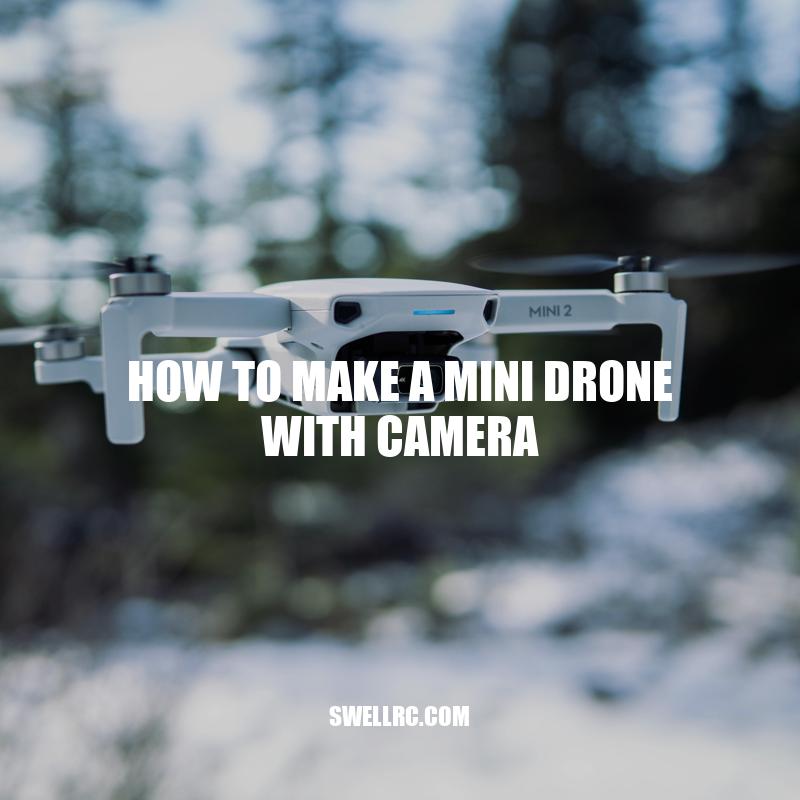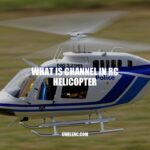How to Make a Mini Drone with Camera: A Step-by-Step Guide
A mini drone with a camera is a popular and fascinating device. Combining your love of flying with your passion for photography, it enables you to record aerial photos or videos from a unique perspective. Building your own mini drone with a camera is a fulfilling and challenging task suitable for hobbyists and professionals alike. The process requires patience, precision, and attention to detail, but the result is a custom drone tailored to your needs, capable of capturing stunning aerial images. In this article, we will guide you through the process of building a mini drone with a camera yourself. We will discuss the necessary equipment, steps to follow, and tips to make the process as smooth as possible. Whether you want to learn more about drone building or capture aerial shots for your personal or professional projects, this article is for you. So, get ready to embark on an exciting journey of building your own mini drone with a camera!
Required Equipment
To build a mini drone with a camera, you will need specific equipment. Here is a list of the required equipment:
- Frame: A stable and lightweight frame for the drone body
- Flight Controller: The brain of the mini drone that provides stability and balance
- Remote Controller: A device that enables you to control the drone in every direction
- Motor: Electric motors for propelling your drone
- Propellers: Four or more propellers to stabilize your drone as it flies
- Battery: A rechargeable battery that powers the drone
- Charger: A device that charges the drone’s battery, so it is ready for flight
- Camera: A mini HD Camera that provides a first-person view of the drone’s perspective
- Video Transmitter: A device that sends live video footage from the camera to your remote controller or other viewing device
You can find equipment for building mini drones at hobby shops or online stores like DJI, and HobbyKing. Look for products that have positive reviews and offer customer support if you have difficulty following the instructions. In the next section, we will discuss how to assemble the frame of the mini drone.
How to make a small mini drone?
Here are the steps on how to make a small mini drone:
- Collect the necessary materials: motors, propellers, a flight controller, a battery, and a frame.
- Assemble the frame: Use the instructions that came with your frame kit to put it together.
- Attach the flight controller: Follow the instructions that came with your flight controller to install it onto the frame.
- Attach the motors: Use screws to attach the motors to the frame according to manufacturer’s instructions.
- Attach the propellers: Place each propeller onto a motor shaft and twist on until tight. Make sure not to get the direction wrong!
- Connect the battery: Hook up the battery to the flight controller and motors, again following instructions provided.
For more detailed instructions, we recommend checking out DIY websites like Instructables or Hackster. Another option is to purchase a mini drone kit from online marketplaces like Amazon or Banggood. These kits already have all the necessary parts and instructions included for easy assembly.
Building the Frame
Once you’ve acquired the necessary equipment, the next and critical step is building the drone’s frame. For this, you must follow the steps given below.
- First, arrange the drone’s arms and attach them to the body using screws.
- Attach the electronic speed controllers’ arms to the frame, make sure that motors face the right way.
- Connect the motor wires to the electronic regulators properly, and make sure that connections are secured to the power distribution board.
- Use a clean, flat surface to construct the drone. Place the flight controller in the center of the frame and secure it with nylon standoffs.
- Install the landing gear for additional security and stability.
It’s essential to balance the frame so that the mini drone’s weight is evenly distributed between its rotors. An unevenly balanced frame will result in unstable and shaky flight characteristics. It’s essential to take your time when building the frame so that everything is correctly secured and stable. Follow an online tutorial or watch videos on YouTube to learn how to properly build a drone.
Here is a table that summarizes the necessary steps for building your drone’s frame:
| Step | Description |
|---|---|
| Step 1 | Arrange the drone’s arms and attach them to the body using screws. |
| Step 2 | Attach the electronic speed controllers’ arms to the frame, make sure that motors face the right way. |
| Step 3 | Connect the motor wires to the electronic regulators adequately, and make sure that connections are secured to the power distribution board. |
| Step 4 | Place the flight controller in the center of the frame and secure it with nylon standoffs. |
| Step 5 | Install the landing gear for additional security and stability. |
It’s important to note that buying quality equipment can be the difference between building a great drone and a failing one. When building your own drone, we recommend buying parts from DJI, one of the most trusted companies in the drone industry.
How to build a drone step by step?
Building a drone can be a fun and rewarding experience, but it requires careful planning and attention to detail. Here are the basic steps to follow:
- Choose a drone kit that fits your skill level and budget. Popular options include DJI, Hobbypower, and Eachine.
- Read the instructions carefully and gather all the necessary tools and equipment.
- Assemble the frame according to the instructions. This usually involves attaching the arms and landing gear to the central body.
- Install the flight controller, which is the brain of the drone that controls its movements.
- Attach the motors and propellers to the frame.
- Connect the electronics, such as the battery, receiver, and transmitter.
- Calibrate the drone and test it thoroughly before flying.
There are many resources available online to help you build a drone, such as YouTube tutorials and forums like RC Groups. You can also find helpful products, such as soldering and crimping tools, on websites like Amazon and SparkFun.
Installing the Flight Controller
A flight controller is an essential component of any drone as it helps stabilize the drone and determines the drone’s flight behavior. Generally, flight controllers integrate an accelerometer, a gyroscope sensor, and a barometer sensor to determine the drone’s orientation and acceleration. Follow the steps below to properly install the flight controller.
- First, unpack the flight controller from its packaging and ensure that you have all the necessary components.
- Identify the correct location to place the flight controller on the drone’s frame. Ensure that it’s placed in the center of the drone’s frame and securely fastened with its mountings.
- Connect the receiver to the flight controller as per the manufacturer’s instructions.
- Solder the quadcopter cables to the flight controller as per the manufacturer’s instructions.
- Ensure that you have loaded the latest firmware on your flight controller to avoid any erratic behavior during flights.
Once the flight controller is correctly assembled and installed, test it and ensure that everything works correctly. You can do so using the transmitter and receiver, which sends commands to the drone for takeoff, hovering and landing, and yawing. In case of any issues or questions, refer to the flight controller manual or online forums for support.
There are many flight controllers available in the market, but it’s crucial to choose the one that suits your drone’s requirements and your flying experience. Popular flight controllers include DJI Naza-M Lite, Pixhawk, and Naze32 FC. Visit your local hobby store or online retailers such as Amazon or Ebay to purchase one.
What is the use of flight controller in drone?
Flight controller is a vital component of a drone that manages the flight system, calculates the movement and stability of the drone, and allows the pilot to control the drone’s flight. It gathers input from sensors such as gyroscopes, accelerometers, and GPS, and uses that information to adjust the speed of the motors and propellers, maintaining the drone’s stability and altitude.
Some popular drone flight controllers include:
Each of these controllers has its own unique features and capabilities, so it’s important to choose the one that best fits your needs.
Adding the Camera and Video Transmitter
Adding a camera and video transmitter is the most crucial step in making a mini drone with a camera. It will allow for real-time viewing and recording of videos and pictures. To add a camera and a video transmitter, follow the steps below.
- Choose a camera and video transmitter with compatible frequencies. Ensure that the camera and video transmitter integrate with each other and are of good quality to produce clear videos and images.
- Mount the camera onto the drone securely, ensuring that it can record a wide angle view facing forward or downward.
- Connect the video transmitter to the camera, and connect the power cables to a battery regulated between 7-12 volts. The power cables should be connected to the flight controller’s power distribution board.
- Set up the video transmitter by channel scanning, then match the channel to the one on the goggles.
- To test if the camera is working, turn on the camera and make sure the video is stable and not flickering. Fix the camera’s position if necessary.
There are several cameras and video transmitters available in the market, including the Foxeer camera, Runcam camera, and Eachine video transmitter. These can be purchased online from platforms such as Amazon or online drones stores such as GetFPV or PyroDrone.
How do I connect my FPV camera to my drone?
Connecting your FPV camera to your drone is a simple process that can be completed in just a few steps:
- Ensure both your camera and drone are powered off before beginning any work.
- Locate the video transmitter (VTX) on your drone, and connect the camera to it using a video cable. Most FPV cameras use a 3-pin or 4-pin wire, but check your camera manual to be sure.
- Connect the VTX to your drone’s power source, following the wiring diagram in the manual.
- Power on your camera and drone, and adjust the camera angle to your preference.
- Lastly, sync your FPV goggles to your camera’s video frequency, and you’re ready to fly!
For further details on connecting your FPV camera to your drone, check out resources like rcdrone101.com or specific product manuals from popular manufacturers like DJI, Fat Shark and Aomway.
Connecting the Remote Controller
The remote controller is a crucial component of the mini drone, as it provides the pilot with the ability to control the drone’s flight and the camera. Here are the steps to connect the remote controller:
- Power up the remote controller, then turn on the receiver and the drone. The receiver will detect the drone’s flight controller, and the controller will beep to indicate the process completion.
- Next, match the channel on the receiver with the controller, then pair the two devices by pressing the designated buttons. The process will require a few seconds, and the controller will beep after completion.
- Once you have paired the controller and drone, check that the receiver channels are synchronized with the flight controller by moving the controls around. The gimbal should move to the desired position for camera control.
- To avoid interference from other devices and ensure a strong signal, calibrate your remote controller and receiver before flight by following the manufacturer’s instructions.
- It is also essential to configure the remote controller to your preferences before flying the mini drone.
Some of the popular remote controllers that can be used for a mini drone with a camera include the FrSky Taranis X9D, DJI Remote controller, Futaba T16SZ, and Radiomaster TX16s. These can be purchased from various online stores, including Amazon and GetFPV. It is essential to choose a controller that is compatible with your drone’s flight controller and has customizable settings for your personal flying style.
How do I connect my remote to my drone?
Connecting your remote to your drone is a crucial step in flying it successfully. Here’s how you can do it:
- Turn on the drone and remote simultaneously.
- Ensure that the remote’s battery level is sufficient.
- Most drones will automatically connect to the remote, but if it doesn’t, follow the manufacturer’s guidelines to synchronize them.
- Once connected, take time to calibrate your drone before flying it.
For more detailed information on how to connect your remote to your drone, check out the manufacturer’s manual or visit their website. There are also many helpful tutorial videos available online from drone enthusiasts and professionals.
Conclusion
Building a mini drone with a camera is an exciting project that combines both aerodynamics and photography. By constructing your own mini drone, you will learn about its mechanics and how it operates, and gain valuable insights into its working principles.
In conclusion, building a mini drone with a camera requires assembling various components and configuring the drone before flight. To make the process easier, you can follow the guidelines included in this article. It’s essential to start with the right equipment and follow the required steps to ensure that the mini drone flies correctly and takes stable footage.
Finally, remember to fly responsibly and adhere to all local regulations governing drone use. Look for open flying areas to practice and become more comfortable controlling the drone. With patience, practice, and attention to detail, building your mini drone with a camera can result in some amazing aerial footage that you may not have been able to capture otherwise.



